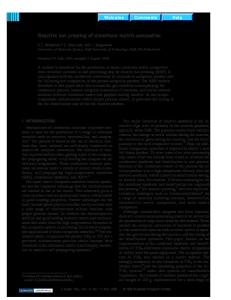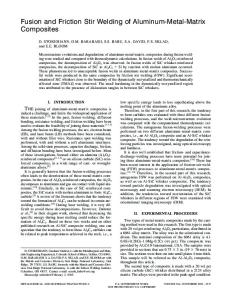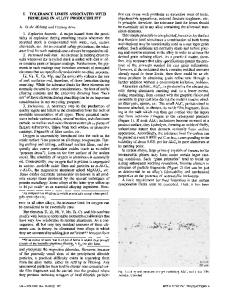Recycling of aluminum matrix composites
- PDF / 334,588 Bytes
- 6 Pages / 612 x 792 pts (letter) Page_size
- 85 Downloads / 454 Views
I.
INTRODUCTION
THE research on the recycling and reclamation of aluminum alloys is becoming active to preserve the natural environment, to save energy, and to reduce garbage.[1–4] The production energy of recycled aluminum alloy ingot is about 3 pct of that of the new ingot.[1] This evidence strongly supports the necessity of recycling of aluminum alloys. Among aluminum alloys, metal matrix composites (MMCs) have high strength, high elastic modulus, and good wear resistance. These composites have been developed to meet the demand for the property, which exceeds that of ordinary metallic materials, to attain the high efficiency of machines and to save energy. Many fabrication processes have been proposed and developed for MMCs.[5,6,7] Aluminum alloy matrix composites have been commercialized for automobile engine parts and outboard engine parts, etc., because of their high specific tensile strength and elastic modulus.[8,9,10] The greenhouse effect by CO2 gas was closed up and became a serious problem of the world. As the efficiency improvement of machines will be effective to reduce CO2 gas release, MMCs, especially light MMCs such as aluminum alloy matrix composites, are expected to be used for the machine components. Since the amount of the MMC products is small, the recycling and reclamation of MMCs has not been a serious problem. However, the recycling will become an important issue in the near future, because the number of MMC products has been steadily increasing. Most of MMC products commercialized today are reinforced with short fibers, whiskers, or particulates, and the volume fraction of the reinforcements is usually less than 30 vol pct. In addition, only a very small part in the products is composite such as a piston for a diesel engine, cylinder block, and a piston for an outboard engine.[10] When scraps of those products produced by a squeeze casting proYOSHINORI NISHIDA, Chief of Composite Materials Laboratory, and NORIHISA IZAWA, Researcher, are with the National Industrial Research Institute of Nagoya, Nagoya 462-8510, Japan. YUKIO KURAMASU, Manager of Shape Casting, is with the Research and Development Centre, Nippon Light Metal Company, Kambara, Shizuoka, 421-3291 Japan. Manuscript submitted April 7, 1998. METALLURGICAL AND MATERIALS TRANSACTIONS A
cess are melted, the composite parts sink to the bottom of the crucible keeping their original shape, and each reinforcement does not drift separately in the melt. Because the preforms are usually made of reinforcements using some inorganic binders, the composite parts can be easily separated from the other part of the MMC products. The important subject for the recycling and reclamation of MMCs is to develop the separation technology of matrix metal from reinforcements. However, there seems to be few articles addressing the separation technique of matrix metals in MMCs,[11,12] and the separation of fibers in composites has not been tried yet from the viewpoint of recycling. The objective of the present work is to develop the separation technology
Data Loading...











